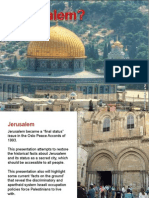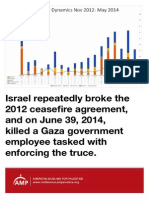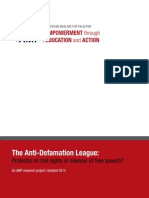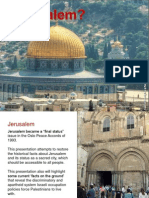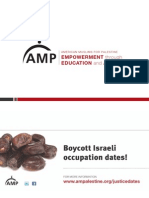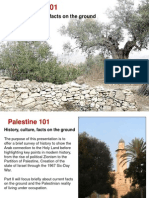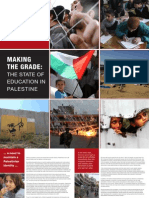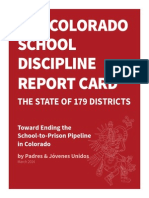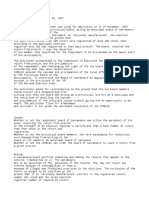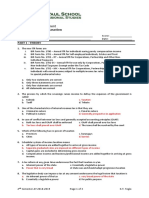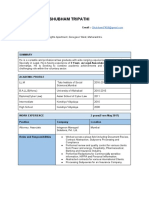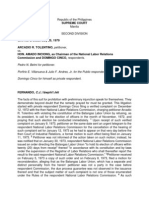Professional Documents
Culture Documents
Everybody Freeze: The Art of Public Demonstrations For Palestine On College Campuses
Uploaded by
Kristin SzremskiOriginal Title
Copyright
Available Formats
Share this document
Did you find this document useful?
Is this content inappropriate?
Report this DocumentCopyright:
Available Formats
Everybody Freeze: The Art of Public Demonstrations For Palestine On College Campuses
Uploaded by
Kristin SzremskiCopyright:
Available Formats
AMERICAN MUSLIMS FOR PALESTINE
EVERYBODY FREEZE!
The Art of Public Demonstrations
for Palestine on College Campuses
Power concedes nothing without a demand - Frederick Douglas
TABLE OF CONTENTS
I. Introduction ............................................................................................. 03
II. 3 2 1 ACTION GETTING STARTED!
A Short Guide to Implementing Public Demonstrations ................................. 03
III. 3 2 1 ACTION - BER CREATIVITY!
Different Methods of Public Demonstrations ................................................ 08
IV. 3 2 1 ACTION - MEDIA!
A short guide to seeking justice by engaging the media ...............................13
V. 3 2 1 ACTION - RESOURCES! ...................................................15
Available materials, speakers list ...............................................................18
EVERYBODY FREEZE!
The Art of Public Demonstrations for
Palestine on College Campuses
Power concedes nothing without a demand - Frederick Douglas
INTRODUCTION
Israels 51-day assault on Gaza in July and August 2014 was a turning point for the global movement to end
Israels occupation of Palestine. Images of bodies in the streets of the Shujaiyya neighborhood of Gaza City
and of terrifed children enraged the world and turned bystanders into activists. Hundreds of thousands of
people took to the streets around the globe to protest Israels violations of human rights. As masses demanded
their governments take action to stop Israel and hold it accountable, the modes of demonstrations became
more urgent and creative. Student groups and community organizations from London to Johannesburg and
from Los Angeles to New Delhi, engaged in one of the most powerful forms of collective expression protest.
Those in power cannot ignore the deafening screams of the enraged public for much longer. The movement is
growing larger and demanding to be heard with one main message: END THE OCCUPATION NOW! END THE
SIEGE ON GAZA NOW!
For that reason, American Muslims for Palestine (AMP), a national education and advocacy organization,
has developed this activism handbook that can be utilized easily by student groups seeking creative ways to
engage their campus communities on Palestine.
Every step toward the goal of justice requires sacrifce, suffering and struggle; the tireless exertions
and passionate concern of dedicated individuals. - Martin Luther King Jr.
Truly, the suffering, struggle, passionate concern and tireless exertions of dedicated student activists across
the country have become a real threat to the Israeli war machine by its own admonition. In order to be more
effective in organizing public demonstrations for the noble and just cause of Palestine, its important to be well
prepared and organized.
PART I
3 2 1 ACTION - GET ORGANIZED!
A Short Guide to Implementing Public Demonstrations
Identify goals and objections
Before your demonstration, ask yourselves the following questions:
* What do you want people who see the demonstration to learn?
* What do you want them to do?
* What objective do you want to reach and how will you reach them?
Answering these questions before your event is extremely important, as the answers will determine your main
course of action. Do you just want people to see how many children died in Gaza? Or do you want them also to
sign a petition to university administrators demanding divestment from companies complicit in the occupation
of Palestine? Its important to determine your goals and outcomes before putting together a demonstration so
your actions are focused and messaging is clear.
4 5
Mobilize a group of dedicated and trustworthy students
For any given demonstration, you will need at least two to four core organizers. You should have a point
person dedicated to these areas: outreach, media, chants, action items, and support/legal observers.
Make sure someone collects the basic contact info of everyone attending the demonstration.
Create Visuals
Most effective public demonstrations require some type of visual that describes or illustrates who is doing the
action and why.
Banners: For example, a die-in with people laying all over the campus grounds is useless without someone
holding a sign notifying people what its about. Rallies and marches should be led off by a lengthy banner that
includes the ask (End the Siege on Gaza now!) and the logos of supporting organizations, if appropriate.
Posters: Visuals should include stats, images, and clear language about the reason for the demonstration.
Avoid images and languages that will be rejected by the average American public. The purpose is to target
people who are largely unaware of what is happening in Palestine with their language and being mindful of
their sensibilities. For instance, the average American will reject bloody pictures and infammatory language as
being not credible and they will consider you a fringe group instead of as people with a thoughtful message.
Concentrate always on international law and human rights and do not, under any circumstances, compare
Israeli policies to the Holocaust or Nazi Germany as that will only detract from your message.
Media Kit
Theres a saying that goes: No media, no event. In other words, if no one outside of some bystanders sees
you or hears your message, you might as well have stayed home. Media outreach before, during and after an
event is crucial.
Media will be handled later in this handbook. For now, this is how to prepare media outreach for an event.
* Media advisory this is a save the date announcement. Send it about four days before the event. Send it
again two days before the event and the morning of the event.
* Calling Even at small outlets, your release may not make it to the intended target. Calling by 7 a.m. the
morning of the event is extremely important to make sure you get on the schedule for that days coverage.
* Press release This is a longer statement that should include the 5 Ws Where, What, Why, When, and
How (Yes, we know its an H and not a W.) This can also include historical background information, and the
list of organizational sponsors.
* Messaging and talking points These are extremely important and should be agreed upon well before the
event and then distributed to volunteers who may be approached by the media. Everyone should stay on these
talking points at all times.
* Media spokesperson It is crucial to have a professional-looking, even-tempered person as the media
contact.
6 7
That person must make himself or herself available at all times. Journalists are crunched for time. If you dont
pick up or return a call in under fve minutes, they will move on to someone else and youve lost your chance
to get your narrative out there.
Materials
You will need certain materials for your actions such as markers, megaphones, signs, tape, etc., and in
most actions you will also need materials to distribute to the public. The American Muslims for Palestine has
developed high-quality, credible educational materials, which are available free of charge to your student
group. Please contact info@ampalestine.org to get a shipment or visit www.ampalestine.org and download
our publications.
Permits
Sometimes campus administrators place restrictions on the time and place of demonstrations. Although we
generally dont agree that these restrictions should be present, we do acknowledge that some actions require
notifying school administrators prior to the action or demonstration. Contact your Student Affairs or Student
Organizations representative to communicate your plans. Most demonstrations should not require any type
of permit, but in order to protect your student group from possible penalties or punishments, communication
is important. If a permit is required for any type of action, make sure to apply for it well in advance so that you
can deal with any problems that may occur without disrupting your original plans.
Get Legal Support
When engaging in public demonstrations, organizers must always be prepared for backlash. Sometimes police,
administrators or the opposition can violate your rights as individuals or as a student group. For that reason, its
important to have some legal observers at your demonstration or action.
Luckily, a group of dedicated organizations, including the Center for Constitutional Rights and AMP, established
the Palestine Solidarity Legal Support network to help Palestine solidarity groups deal with legal issues and
challenges to their rights. It is a good idea to reach out to them before your event to make them aware of
your plans. They can provide guidance as to what is and isnt legally acceptable. They are also expert at
dealing with pushback from university administrations. For more information or inquiry please contact info@
palestinelegalsupport.org or call 312.212.0448.
You can also reach out to your local National Lawyers Guild or American Civil Liberties Union Chapters for
some help with legal observers. Local Muslim civil rights organizations like Council on American-Islamic
Relations (CAIR) or South Asian Network (SAN), can be of assistance as well.
GAME TIME
What to do during an action/demonstration
Arrive Early
Now that youve organized your group and everyone has their roles set, make sure to arrive at your
demonstration location early. Doing so allows you to get a feel for the atmosphere of the demonstration. Youll
also have time to head off any potential logistical problems that may arise.
Group Huddle
Prior to the event, your main organizers should get together to hash out last minute details, such as confrming
the chant leader and making sure everyone stays on the agreed-upon messaging. This pre-demonstration
meeting is essential so you can ascertain beforehand if there is something missing and fll it in rather than
doing it during the demonstration. This is key, considering youll have a live audience and, potentially, media.
Delegating
To ensure a smooth fow of things, make sure to have your designated people in the right positions. The media
person should be known and available to speak with media. The volunteer organizer should be visible and
directing others. The group photographer should be in place and ready with all necessary equipment. Every
persons task plays a crucial in the success of your demonstration.
Agitators
Designate volunteers to deal with hecklers and others coming to distract people away from your demonstration.
Experience shows that having a personal dialogue with agitators on the side helps keep the attention on the
demonstration and not on the troublemakers. It is imperative that the designated volunteers be experienced,
even-tempered people who are able to rise above personal attacks and other inciting language. It only takes
one moment of heated exchange to catch the medias attention and thats what will get played on the local
news that night, thereby negating the point of your demonstration.
Team Leader
Having a rotating team lead for each event helps build leadership skills in various members of your group. Also,
it allows different individuals to take some ownership of demonstrations and major actions done by the group.
The team leader should be the one to directly communicate with police and administrators throughout the
demonstration.
8 9
THE DEBRIEF
Ensuring a Successful Outcome to Your Demonstration
Post Event Huddle
Also known as the debrief. This is vital because invariably situations arise, which you didnt
anticipate. Youll need to discuss these things with the team and come up with a plan to address
them. Debriefng is necessary even if the action went perfectly as well. You can discuss with
organizers how you can best move forward with raising awareness and capitalizing off of the energy
built during the demo.
Building Up
Sure that you collect the information of everyone present. Organizers and participants alike need to
stay in touch after the event. You may have had people join the demonstration that were not part of
the original group. Email sign-up sheets are essential just make sure you dont lose it to agitators or
infltrators.
Press Release
Send out a press release immediately after the event to media outlets. You also should upload video, pictures
and the press release to community journalism sites. (More on this in the Media section.) This is important
because it allows you control the narrative. It is important to have a press release prepared that you can make
minor edits to and send to media outlets immediately.
Everybody Clean Up!
Make sure you leave no footprint in the area of your rally or demonstration. Getting slapped with a fne or
leaving the place full of litter will refect poorly on your student group and could make it diffcult to get permits
in the future. It also kills the feeling of success and victory if youre penalized over something that was entirely
preventable.
Thank You!
Thank everyone who participated and reinforce their spirit with an exit speech. This will do wonders to ensure a
high turn-out for the next demo.
PART II
3 2 1 ACTION - BER CREATIVITY
Different Methods of Public Demonstrations
Power never steps back, except in the face of more power. - Malcolm X
Powerful forms of expression have historically been the impetus for transforming the world. Whether it is the
raising of the loaf of bread during the French Revolution or athletes raising black-gloved fsts on the awards
podium in the 1968 Olympics or the harmonious chants of revolutionary protesters in Egypts Tahrir Square,
people have found alternative ways to strikingly make their point. Below are just a few ideas out of many that
can be done by Palestine activists on campus.
The Die-In
The Die-In has proven to be an extremely effective way of getting more people involved and making a powerful
statement in public spaces every where. The Die-In consists of a group of people representing those who have
lost their lives in unjust situations by dying in public. Each body represents a lost soul. This can be done in
a variety of ways, including but not limited to, stating the
names of those killed; wearing signs bearing the names of
those killed; wearing bloodied clothing; posting signs with
the names of those killed around those who are dead on
the foor; an announcer on megaphone stating the names
of the deceased; or a silent die-in with everyone dying at
the same time. Die-In cover a large space on the ground
and are very hard to miss. They are a dramatic illustration
of what reality is like for those in Gaza and elsewhere, who
have seen bodies strewn in the streets. Its a good idea to
have an announcer state the facts and statistics you want
to get across to the public as activists who have died lie
on the ground. Always use the opportunity to educate and
mobilize.
Number of Demonstrators: At least 20
Suggested Materials: Bullhorn/megaphone, index cards, list of killed, fake blood, scotch tape, signs, photo
camera, video camera, Palestinian fags
Handouts: See the list of AMP materials available for your use, free of charge, in the Resource section.
Flash Mob
Dabka, dabka, dabka
Flash Mobs might not be useful for political protests, but they are a fun and energetic way to assert Palestinian
culture, especially with the Palestinian folklore dance, dabka. Your student group could coordinate people
to gather randomly at a certain place and time in the center of campus. Designate someone to hook up a
smartphone to a small speaker to play Palestinian nationalistic songs. Start a dabka line and have volunteers
planted to join in, and Bam!, you have a Dabka Flash Mob. Make sure you have someone recording it on
video.
10 11 10
This kind of fashmob tends to get many of views on YouTube. Considering Israels policy of ethnic cleansing,
and the propensity to appropriate Palestinian culture, holding onto deep cultural practices such as dabka are in
and of themselves an act of resistance.
Number of Demonstrators: 15 or more.
Suggested Materials: Kuffyehs, Palestinian Flag, iPod/Android plug-in speaker, really good dabka song
Handouts: See the list of AMP materials available for your use free of charge in the Resource section.
Funeral Procession
A funeral procession consists of demonstrators carrying cardboard coffns across campus and meeting at a
place to bury the dead. This can be an extremely effective demonstration if everyone wears black, some
hold signs, and others march silently (or not). Fake coffns with the Palestinian fag draped on top are visually
shocking, especially if some people carry dolls wrapped in white cloth with blood stains. This can truly be a
shocking scene on campus and can solicit many questions from onlookers.
Number of Demonstrators: 10+
Suggested Materials: Cardboard coffns, Palestinian fags (no pole), masking tape, signs, megaphone/
bullhorn, dolls, white sheets, fake blood
Handouts: See the list of AMP materials available for your use free of charge in the Resource section
Sit-In
The Sit-In protest is a form of civil disobedience which, if done correctly, can garner great media coverage.
It can help memorialize or ceremonialize your action, but it usually doesnt actually stop an action or compel
an action to take place. Therefore, civil disobedience should always be the last resort. It cannot replace direct
actions such as calling decision makers, forwarding petitions, engaging the media, etc. We have seen that
increasingly Palestine solidarity activism is being criminalized across the country. In every case, whether youre
conducing a sit-in or a rally, it is important that you and your volunteers dont give the appearance that you are
sympathetic to or support any illegal activity. For instance, avoid getting into discussions about violence, even if
it seems youre just joking around. Agent provocateurs often try to appear as one of the group, and then try to
prompt others around into inappropriate speech, which they record and upload online. It is extremely hurtful to
your work when this happens.
If your group decides to conduct a Sit-In, please inform your members that the risk of arrest is relatively strong
and only those students who are prepared to go this route should participate. Others can play a supporting role
by alerting the media, sending out real-time updates via social media, or recording the event.
To achieve success, it is imperative to have as many volunteers as possible as well as a strong media
presence.
Number of Demonstrators: 25+
Suggested Materials: Smart phones, photo/video cameras, signs, manila folders (for those getting arrested to
put belongings in before getting arrested), markers, masking tape, lace-less shoes
Handouts: You wont need handouts for this action but keep your internal messaging
12 13
Teach-In
Teach-Ins are benefcial when academics join the cause and are interested in engaging the issue publicly.
Graduate students, professors, and some undergraduates can all do teach-ins. Public teach-ins, outdoors on
school grounds (rather than the classroom) are an extraordinary way of academically discussing the desired
narrative. The idea of having a professor with a white board, outside on the campus lawn, teaching a class is
not an everyday occurrence and is bound to get some attention. Use this as an opportunity to work with the
more academically inclined students, those who prefer to stay away from other forms of public demonstrations.
Number of Demonstrators/Attendees: 20+
Suggested Materials: White board/chalk board, easel, small sound system, consisting o microphone and
small speakers. If this is not available, then use bullhorns or megaphones. Signs are also helpful.
Handouts: Its helpful to have handouts specifc to the topics being discussed. AMP also has many materials
to choose from. See the section on Media for a complete list.
The Wall
Many student groups around the country have built a mock apartheid wall that resembles that in the West
Bank. Aesthetically, the wall is a valuable resource. It conveys to the onlooker the impact of the apartheid wall,
while allowing you the opportunity to post relevant and important information. The wall is a piece of art and an
informational tool. Some walls are massive and have an unrelenting presence on campus, while others are
simply banners pieced together lightly. Either way, do what your student group is capable of putting together.
For information on putting up a large, imposing wall on your campus on the West Coast or in the Midwest,
please contact American Muslims for Palestine at info@ampalestine.org. AMP has two walls for students use
in these regions.
Number of Demonstrators: It usually takes at least 6 committed people to assemble a wall of the size seen
below. At least 2 people should be around the wall throughout the day.
Suggested Materials: The wall, hammers, extra hinges, bolts, workmans gloves, back support suspenders,
signs, cameras, megaphone/bullhorn
Handouts: See the list of AMP materials available for your use free of charge in the Resource section
PART IV. 3 2 1 ACTION!
A short guide to seeking justice by engaging the media
Create a media strategy beforehand
The importance of messaging cant be understated. Creating your messaging and talking points beforehand
ensures everyone stays on point. Remember the old saying, No media, No event. In other words, what have
you accomplished if just a small group of people witnessed your action? Increase your impact by getting your
message carried far and wide through news articles, broadcasts and community journalism sites.
To begin, ask yourself these questions
* What do we want to achieve with this action?
* What key principles can we build our message around?
* How do we want to get our message out?
Identify what you want to achieved and then plan accordingly. Do you want the mainstream media to cover
your event? Do you want a video to go viral? Do you want to educate the masses or just focus on a local
community?
What principles do you want to convey? For instance Israels occupation is illegal and violates Palestinian
human rights? It is not anti-Semitic to criticize the policies of a government? Congress must investigate
whether Israels use of American weapons in Operation Protective Edge violated the US Arms Export Control
Act? Decide beforehand and then use that principle to inform your talking points.
Once you decide upon the above issues, youll have a better idea of how you want to get out your message,
i.e., sending a media advisory, holding a press conference or using social media to alert journalists.
Messaging and Talking Points
Once you determine what you want to accomplish with your demonstration or event and what principles you
want to convey, then you can create your messaging and talking points.
Messaging is created around the key principle(s) you decided upon and talking points are quick bullet points of
facts and statistics that support that message. Talking points should not stray, lest you lose your focus and your
message becomes weak.
For instance, AMP and the International Jewish Anti-Zionist Network once had a campaign called Never Again
for Anyone, that promoted Holocaust survivors speaking out against the occupation. Our goal was to get
people to understand that criticizing Israeli policies that violate international law and human rights is not anti-
Semitic. Our principles were:
* Anti-Semitism is bias based upon religion or ethnicity. Criticizing governments is not anti-Semitic.
* Affording one people their rights does not detract from the rights of another people.
* The occupation violates international law and deprives Palestinians of their basic human rights.
So all messaging/talking points hit home on these three principles.
14 15
Then the talking points were given to volunteers at each event held across the country in case any of them was
approached by media. In this way, we were able to control the message as much as possible to drive home our
principles in the massive media coverage the campaign received even when the articles were hostile.
How to alert the media
Media advisory - Media advisories are like save the date cards. They are meant to alert the media to an
upcoming event with a brief statement about who is holding the event and why. Media Advisories are meant to be
short and do not contain background historical information.
Always remember to get your main point out in the frst two paragraphs or you run the risk of having an editor
tossing the advisory without ever being read. Media advisories should be sent about four to fve days before the
event, the day before the event and by 6 a.m. the morning of the event. At around 7 a.m., personal phone calls to
the news desk or assignment desk should be made to ensure the planning editors or assignment producers are
aware of the event and will get it on their daybooks.
Here is the format:
MEDIA ADVISORY
Contact
Name
Event organizer
phone; email
HEADLINE
(DATELINE i.e., city, and date) First paragraph must contain the particulars.
Second paragraph Should contain the Who, What, Where, When and Why
Third paragraph One line to put the event in context
Fourth paragraph List supporting organizations.
Heres an example:
MEDIA ADVISORY
Contact:
Kristin Szremski
Director of Media
708.717.4180
media@ampalestine.org
Press conference to discuss removal of Egyptian President Mohammed Morsi
Local Egyptian Americans to give frsthand accounts
(CHICAGO 09/09/2013) A coalition of Chicago-area human rights organizations are holding a press
conference at 11 a.m., Tuesday, Sept. 10, 2013 at Downtown Islamic Center, 555 State St., Chicago.
The purpose of the event is to discuss the situation unfolding in Egypt that has left hundreds of people dead
throughout the country. Local Egyptian Americans who have just returned from Cairo will give frst-hand accounts
and will be available for interviews.
Endorsing organizations are Egyptian Americans for Democracy and Human Rights, American Muslims for
Palestine, and Council of Islamic Organizations of Greater Chicago.
-- END --
Using social media - Often you can alert the media through each outlets Facebook page or Twitter accounts.
Nowadays, each outlet lists their social media accounts and Twitter names. Create a campaign using your
talking points, and Tweet at certain reporters or outlet news desks. If youve created a Facebook event, post
the link on outlets Facebook pages or message the link to them, if they dont allow posting to their pages.
Press Releases - Press releases are longer forms of the media advisory but instead of informing of an
upcoming event they are used to disseminate your message.
Press releases should be given to the media during your event. If some outlets are absent, send them the
press release with pictures immediately after your event and you may be able to have something published on
their websites.
Write your press release in an inverted pyramid style, meaning the most important information is included at
the top and the least important at the bottom. Press releases should contain one to two quotes from an event
organizers. Remember, your press release should stick to your talking points as well.
Format:
FOR IMMEDIATE RELEASE
Contact
Name
Event organizer
phone; email
HEADLINE
(DATELINE i.e., city, and date) Paragraph I Must contain Who, What, Where, When and Why
Paragraph II This can expand on the Why you held the event.
Paragraph III Quote from an organizer that forwards your message. It should contain new information and not
just restate the frst two paragraphs.
Paragraph IV Historical context. i.e., Students convened the rally to show solidarity with the Palestinians of
Gaza, who have been under attack by Israeli military forces for more than four weeks. So far, Israels attacks
have killed more than 1,500 Palestinians, 70 percent of them civilians, according to the United Nations.
Paragraph V More historical context, if necessary. (This paragraph can be skipped.)
Paragraph VI Another organizer quote
Paragraph VII The list of supporting organizations
Note: Try to keep your press release to just one page. It should never exceed two pages. Avoid activist
jargon. Remember, youre trying to get the media to take you seriously so use non-propaganda language. For
instance, when referring to Israel, just call it Israel. Dont use hyperbolic terms like terrorist state, and do not
under any circumstances compare its policies to Nazi Germany or the Holocaust. Using propagandized or
emotional language will take away from your message and youll lose your credibility as well.
Community Journalism - Maybe the media doesnt show up at your event. These days, that doesnt mean
you cant get good coverage, thanks to the rise of community journalism. Many organizations now have areas
on their websites where you can upload your own news stories, videos and photos. Go ahead, and post your
press release or wrap up article online. Just make sure to keep to your messaging and talking points, and avoid
propaganda language. Make sure you cite all your facts to keep your story credible.
16 17
In each case you will have to create a personal account. Remember, these sites in many cases are associated
with mainstream news organizations. But even if they arent, you must ensure that the articles you post are
factually accurate, credible and do not contain propaganda. Your credibility as an activist and that of the group
youre associated with are at stake. Also, how you report an event ultimately refects on the media battle for
Palestine itself.
Some community journalism sites:
CNN iReport www.ireport.cnn.com
CNN producers mine content put up on the community page for story ideas or for pictures and videos to
broadcast on CNN. If the articles are factual and sources are sited, you have a good chance of getting a
blurb broadcast on TV. But even if this doesnt happen, the CNN iReport community has more than 1 million
members so your posts are apt to get a lot of attention.
Newsvine www.newsvine.com
Newsvine is owned by MSNBC, which also draws its on-air and online content from stories posted by
community journalists. Citizen journalists can publish their own articles, MSNBC will draw content from users,
who can publish their own stories or link to outside articles you may think MSNBC should be aware of
Digital Journal www.digitaljournal.com
Digital Journal is recognized as a pioneer and leader in social news, blending professional content with high-
quality user-generated contributions to inform our audience about whats happening around the world.
Ground Report www.groundreport.com
Ground Report is like a journalism lab, where amateurs, students, apprentice and professional journalists can
upload their work and have the opportunity to reach a global audience. Each users content is archived in
personal portfolios, which is helpful for someone majoring in marketing, communications or journalism.
DEMOTIX www.demotix.com
DEMOTIX, which started as a site for photojournalists to sell their work worldwide, is a bit more for serious
writers but it can be a useful platform for activists as well. DEMOTIX is one of the only sites that actually will
pay a reporter. If your story is picked up by a news organizations, DEMOTIX will split the proceeds with you
50/50...
Please keep in mind that your local news outlets also may have community journalism pages on their websites.
Before your event, take some time to scope out the outlets, from the small weekly papers in your region, to the
local network affliates. It can really help you get your story publicized.
Press conference - Historically, press conferences were a great way to engage the media. Reporters liked
it because they didnt have to work too hard to get the information they needed to write their stories. Now,
because the Internet, falling ad revenue and rising overhead costs, traditional newsrooms have been gutted
and they are operating on a very small staff, relatively speaking.
News outlets just dont have the time or manpower to attend press conferences. But that doesnt mean you
shouldnt try. Here are some surefre tips to help you have a successful press conference:
Humanize the story Find local people with ties to your issue the media can interview and have them speak
at the press conference.
Do youR due-diligence work Send out a media advisory announcing the press conference at least twice.
Call outlets by 7 a.m. the morning of the press conference.
Timing The best times and days for press conferences are 11 a.m. on Tuesdays and Wednesdays. However,
if theres major breaking news on say, Friday, and you can act fast to pull a presser together, then dont wait
until Tuesday or Wednesday when interest in the story may have passed. Timeliness is everything.
The Domino Effect If you make you calls by 7 a.m. on the day of the event, all it takes is to get just one
mainstream news affliate to confrm in order to get others participations. No news organization likes to be
scooped and they all are aware of what each other is doing. This is not a guarantee, but its a good chance
that if you can one affliate like ABC and one main newspaper to confrm or at least get your event on the
planning daybooks, youll get other outlets at your event as well.
Press conference is a go. What to do? Be at the site early. Try to have a podium for microphones. Have
a moderator and three to four speakers lined up. Make sure everyone is aware of your talking points and
messaging goals and get their pledge to stick to them!
Banner - Try to have a banner or sign behind you so it is always in the frame behind the speaker. Get some
volunteers to stand behind the speakers silently so the public will see the extra support.
Designated spokesperson - Have a designated media spokesperson to hand out the press release, gather
reporters contact information, and to help facilitate interviews with speakers after the press conference.
Control the fow - Whatever you do, do not open up the foor for questions by anyone other than the media.
Believe it or not, this has happened at press conferences in the past. There is no quicker way to lose control of
your messaging than by allowing spectators to ask questions.
For more information on media work, to schedule media training or for help writing press releases, media
advisories or articles, please contact AMPs Media Department at media@ampalestine.org. AMP also has a
Media Training Handbook and some PowerPoint with useful tips.
Resources:
AMP Educational Materials
* Rising from the Ashes: Gazas Indestructible Spirit A graphic treatment of the result of several studies on
the siege of Gaza and Operation Cast Lead.
* The Truth behind Israels Attack on Gaza: Myth VS. Fact
* Fact Sheet - Gaza Student Fact Sheet
* Fact Sheet - U.S. Aid to Israel
* Fact Sheet Random Arrests and Detentions
* Brochure Apartheid: Separate but Unequal
* Brochure Palestine 101
For a full list of AMP materials, a material request form, Power Points, videos and posters for your use, go to
the Campus Activism section of our website, www.ampalestine.org.
You can also contact AMP National Campus Coordinator Taher Herzallah at taher@ampalestine.org or
download the materials request form at www.ampalestine.org.
18 19 18
AMP Speakers
Dr. Hatem Bazian
AMP Chairman, senior lecturer in Near Eastern and Ethnic Studies at UC Berkeley
Topics: Islamophobia and its connection to Zionism; international law and Palestine; Zionism and the colonial
settler enterprise; and building joint-struggle coalitions.
Dr. Osama Abu Irshaid
AMP National Board member, Editor of Al Mezan newspaper
Topics: US foreign policy; US aid to Israel; Political analysis of the Middle East and how it relates to Palestine;
the importance of legislative work in the US
Taher Herzallah
AMP National Campus Coordinator
Topics: BDS, activism training, dealing with pushback on campus
Kristin Szremski
AMP National Director of Media and Communications
Topics: Creeping Normalcy Identifying Zionist organizations tactics to co-opt Palestine solidarity activism
through interfaith cooperation; Zionist misuse of Title VI to stop campus activism and how to combat
it; Traditional and social media training; Advanced writing workshop how to get your op-ed and press
conference published.
Tarek Khalil
AMP Chicago volunteer
Topics: History of Palestine from political Zionism to present day; and Palestinian rights under international law
AMP Educational Committee
Palestine history lecture series available. Call 708.598.4267, ext. 24.
Conclusion
Public demonstrations are part and parcel of our efforts to create meaningful change for our brothers and
sisters in Palestine. They proclaim that humanity as a whole, those who make up the grassroots movement,
stand with Palestine. The people united, will never be defeated.
For information on materials, public demonstrations, media help, and legal support, go to the Campus Activism
page on our website at www.ampalestine.org. You can also contact us at info@ampalestine.org.
The greatest struggle is to speak the truth in the face of an oppressive tyrant. Prophet Muhammad
P. 708.598.4267
E. info@ampalestine.org
American Muslims for Palestine
To download a PDF file of this booklet, go to: www.ampalestine.com
AMERICAN MUSLIMS FOR PALESTINE
You might also like
- Campus Activism HandbookDocument11 pagesCampus Activism HandbookKristin SzremskiNo ratings yet
- Creeping Normalcy A.K.A. FaithwashingDocument16 pagesCreeping Normalcy A.K.A. FaithwashingKristin SzremskiNo ratings yet
- What About Jerusalem?Document28 pagesWhat About Jerusalem?Kristin Szremski0% (1)
- Gaza Posters To DownloadDocument35 pagesGaza Posters To DownloadKristin SzremskiNo ratings yet
- Summer of Fire - The Truth Behind Israel's Attack On GazaDocument25 pagesSummer of Fire - The Truth Behind Israel's Attack On GazaKristin Szremski0% (1)
- Ramadan Date Boycott Power Point.2015Document18 pagesRamadan Date Boycott Power Point.2015Kristin SzremskiNo ratings yet
- Materials Request FormDocument1 pageMaterials Request FormKristin SzremskiNo ratings yet
- UPDATED WITH NEW INFO! The Truth Behind Israel's Attack On Gaza: Myth Vs FactsDocument12 pagesUPDATED WITH NEW INFO! The Truth Behind Israel's Attack On Gaza: Myth Vs FactsKristin SzremskiNo ratings yet
- Daily Life Under OccupationDocument36 pagesDaily Life Under OccupationKristin SzremskiNo ratings yet
- The Indigenous Palestinians - Twice Dispossessed by Biblical TextsDocument4 pagesThe Indigenous Palestinians - Twice Dispossessed by Biblical TextsKristin SzremskiNo ratings yet
- UPDATED 2014 - The Anti-Defamation League: Protector of Civil Rights or Silencers of Free Speech?Document24 pagesUPDATED 2014 - The Anti-Defamation League: Protector of Civil Rights or Silencers of Free Speech?Kristin SzremskiNo ratings yet
- What About JerusalemDocument28 pagesWhat About JerusalemKristin SzremskiNo ratings yet
- AMP Quarterly NewsletterDocument4 pagesAMP Quarterly NewsletterKristin SzremskiNo ratings yet
- Postcard For ObamaDocument1 pagePostcard For ObamaKristin Szremski100% (1)
- This Ramadan, Make A Date With Justice! Boycott Israeli DatesDocument18 pagesThis Ramadan, Make A Date With Justice! Boycott Israeli DatesKristin SzremskiNo ratings yet
- The Illegal Closure of The Gaza Strip: Collective Punishment of The Civilian PopulationDocument103 pagesThe Illegal Closure of The Gaza Strip: Collective Punishment of The Civilian PopulationPaul V. CassidyNo ratings yet
- Palestine 101Document12 pagesPalestine 101Kristin SzremskiNo ratings yet
- Palestine 101Document40 pagesPalestine 101Kristin SzremskiNo ratings yet
- UN HRC Flotilla Attack Report 9Document66 pagesUN HRC Flotilla Attack Report 9Kristin SzremskiNo ratings yet
- EXPOSED: An Examination of The Anti-Defamation LeagueDocument24 pagesEXPOSED: An Examination of The Anti-Defamation LeagueKristin SzremskiNo ratings yet
- Targeted Civilians: A PCHR Report On The Israeli Military Offensive Against The Gaza Strip (27 December 2008 - 18 January 2009)Document184 pagesTargeted Civilians: A PCHR Report On The Israeli Military Offensive Against The Gaza Strip (27 December 2008 - 18 January 2009)Raphael McNamaraNo ratings yet
- Making The Grade: The State of Education in PalestineDocument9 pagesMaking The Grade: The State of Education in PalestineKristin SzremskiNo ratings yet
- Fact FinderDocument8 pagesFact FinderKristin SzremskiNo ratings yet
- EU East Jerusalem 2010Document11 pagesEU East Jerusalem 2010Angela Godfrey-GoldsteinNo ratings yet
- Caution Children Ahead: The Illegal Behavior of The Police Toward Minors in Silwan Suspected of Stone ThrowingDocument29 pagesCaution Children Ahead: The Illegal Behavior of The Police Toward Minors in Silwan Suspected of Stone ThrowingKristin SzremskiNo ratings yet
- Unsafe Space enDocument59 pagesUnsafe Space enKristin SzremskiNo ratings yet
- Systematic & Institutionalised Ill-Treatment & Torture of Palestinian Children by IL AuthoritiesDocument118 pagesSystematic & Institutionalised Ill-Treatment & Torture of Palestinian Children by IL Authoritieszeitgeist-explorateurNo ratings yet
- Al Nakba Preserving Our NarrativeDocument60 pagesAl Nakba Preserving Our NarrativeKristin SzremskiNo ratings yet
- Unsafe Space enDocument59 pagesUnsafe Space enKristin SzremskiNo ratings yet
- Shoe Dog: A Memoir by the Creator of NikeFrom EverandShoe Dog: A Memoir by the Creator of NikeRating: 4.5 out of 5 stars4.5/5 (537)
- The Subtle Art of Not Giving a F*ck: A Counterintuitive Approach to Living a Good LifeFrom EverandThe Subtle Art of Not Giving a F*ck: A Counterintuitive Approach to Living a Good LifeRating: 4 out of 5 stars4/5 (5794)
- Hidden Figures: The American Dream and the Untold Story of the Black Women Mathematicians Who Helped Win the Space RaceFrom EverandHidden Figures: The American Dream and the Untold Story of the Black Women Mathematicians Who Helped Win the Space RaceRating: 4 out of 5 stars4/5 (890)
- The Yellow House: A Memoir (2019 National Book Award Winner)From EverandThe Yellow House: A Memoir (2019 National Book Award Winner)Rating: 4 out of 5 stars4/5 (98)
- The Little Book of Hygge: Danish Secrets to Happy LivingFrom EverandThe Little Book of Hygge: Danish Secrets to Happy LivingRating: 3.5 out of 5 stars3.5/5 (399)
- A Heartbreaking Work Of Staggering Genius: A Memoir Based on a True StoryFrom EverandA Heartbreaking Work Of Staggering Genius: A Memoir Based on a True StoryRating: 3.5 out of 5 stars3.5/5 (231)
- Never Split the Difference: Negotiating As If Your Life Depended On ItFrom EverandNever Split the Difference: Negotiating As If Your Life Depended On ItRating: 4.5 out of 5 stars4.5/5 (838)
- Elon Musk: Tesla, SpaceX, and the Quest for a Fantastic FutureFrom EverandElon Musk: Tesla, SpaceX, and the Quest for a Fantastic FutureRating: 4.5 out of 5 stars4.5/5 (474)
- The Hard Thing About Hard Things: Building a Business When There Are No Easy AnswersFrom EverandThe Hard Thing About Hard Things: Building a Business When There Are No Easy AnswersRating: 4.5 out of 5 stars4.5/5 (344)
- Grit: The Power of Passion and PerseveranceFrom EverandGrit: The Power of Passion and PerseveranceRating: 4 out of 5 stars4/5 (587)
- On Fire: The (Burning) Case for a Green New DealFrom EverandOn Fire: The (Burning) Case for a Green New DealRating: 4 out of 5 stars4/5 (73)
- The Emperor of All Maladies: A Biography of CancerFrom EverandThe Emperor of All Maladies: A Biography of CancerRating: 4.5 out of 5 stars4.5/5 (271)
- Devil in the Grove: Thurgood Marshall, the Groveland Boys, and the Dawn of a New AmericaFrom EverandDevil in the Grove: Thurgood Marshall, the Groveland Boys, and the Dawn of a New AmericaRating: 4.5 out of 5 stars4.5/5 (265)
- The Gifts of Imperfection: Let Go of Who You Think You're Supposed to Be and Embrace Who You AreFrom EverandThe Gifts of Imperfection: Let Go of Who You Think You're Supposed to Be and Embrace Who You AreRating: 4 out of 5 stars4/5 (1090)
- Team of Rivals: The Political Genius of Abraham LincolnFrom EverandTeam of Rivals: The Political Genius of Abraham LincolnRating: 4.5 out of 5 stars4.5/5 (234)
- The World Is Flat 3.0: A Brief History of the Twenty-first CenturyFrom EverandThe World Is Flat 3.0: A Brief History of the Twenty-first CenturyRating: 3.5 out of 5 stars3.5/5 (2219)
- The Unwinding: An Inner History of the New AmericaFrom EverandThe Unwinding: An Inner History of the New AmericaRating: 4 out of 5 stars4/5 (45)
- The Sympathizer: A Novel (Pulitzer Prize for Fiction)From EverandThe Sympathizer: A Novel (Pulitzer Prize for Fiction)Rating: 4.5 out of 5 stars4.5/5 (119)
- Her Body and Other Parties: StoriesFrom EverandHer Body and Other Parties: StoriesRating: 4 out of 5 stars4/5 (821)
- Factors that Increase Obedience and Causes of DisobedienceDocument4 pagesFactors that Increase Obedience and Causes of Disobedienceatif adnanNo ratings yet
- Colorado School Discipline Report CardDocument17 pagesColorado School Discipline Report CardMichael_Lee_RobertsNo ratings yet
- Vda de Ramos Vs Court of Appeals 1Document2 pagesVda de Ramos Vs Court of Appeals 1sally deeNo ratings yet
- Charlton Hestons RhetoricDocument10 pagesCharlton Hestons RhetoricJay LainoNo ratings yet
- Aguinaldo Vs AguinaldoDocument1 pageAguinaldo Vs AguinaldoKM MacNo ratings yet
- 2 Gr-No-221697-Poe-V-Comelec-Pres-Candidacy-CaseDocument12 pages2 Gr-No-221697-Poe-V-Comelec-Pres-Candidacy-CaseEllen DebutonNo ratings yet
- US National Service DebateDocument37 pagesUS National Service DebatePeter Zhang100% (1)
- CO Elections Rules on Party-List GroupsDocument39 pagesCO Elections Rules on Party-List GroupsJamieNo ratings yet
- Banaras Hindu University Law School: Alternative Dispute ResolutionDocument28 pagesBanaras Hindu University Law School: Alternative Dispute ResolutionrakeshNo ratings yet
- Employment at WillDocument1 pageEmployment at WillJamie SandersonNo ratings yet
- Doctrine of Extra-Territorial OperationDocument31 pagesDoctrine of Extra-Territorial Operationirisha anandNo ratings yet
- Boim V AMPDocument51 pagesBoim V AMPSamantha MandelesNo ratings yet
- IGR Concept of InterdependenceDocument5 pagesIGR Concept of InterdependenceZhanice RulonaNo ratings yet
- Article 208, Revised Penal Code - Prosecution of Offenses Negligence and Tolerance - The Penalty of Prision Correccional inDocument6 pagesArticle 208, Revised Penal Code - Prosecution of Offenses Negligence and Tolerance - The Penalty of Prision Correccional inRuth LumibaoNo ratings yet
- Demapiles Vs COMELECDocument2 pagesDemapiles Vs COMELECKelly EstradaNo ratings yet
- Pre-Test 1 - ProblemsDocument3 pagesPre-Test 1 - ProblemsKenneth Bryan Tegerero TegioNo ratings yet
- Class 10 English First Flight - Nelson Mandela - Long Walk To FreedomDocument9 pagesClass 10 English First Flight - Nelson Mandela - Long Walk To FreedomShivam YadavNo ratings yet
- Shubham Tripathi CV PDFDocument3 pagesShubham Tripathi CV PDFShubham TripathiNo ratings yet
- Bunag, JR v. CA 211 SCRA 441 (1992)Document37 pagesBunag, JR v. CA 211 SCRA 441 (1992)Ruab PlosNo ratings yet
- The Rise and Fall of Japanese As A Divine RaceDocument14 pagesThe Rise and Fall of Japanese As A Divine RaceHimani RautelaNo ratings yet
- 57 VASAK KAREL The International Dimensions of Human RightsDocument774 pages57 VASAK KAREL The International Dimensions of Human RightstaysantlordNo ratings yet
- CRPC ProcedureDocument357 pagesCRPC ProcedureNagaraj Kumble92% (13)
- Handbooktoengli00dewa PDFDocument512 pagesHandbooktoengli00dewa PDFAkanksha Damini JoshiNo ratings yet
- Cases For PubOff Carlota August 23Document33 pagesCases For PubOff Carlota August 23Aldrin Paul Gersaniva ArugayNo ratings yet
- Bacon reviewofArchieBrownTheMythoftheStrongLeaderprepublicationversionDocument1 pageBacon reviewofArchieBrownTheMythoftheStrongLeaderprepublicationversionKhalidsaifullahNo ratings yet
- Civic Engagement Mind Map PDFDocument1 pageCivic Engagement Mind Map PDFSiti RohayuNo ratings yet
- 02 Abella vs. National Labor Relations Commission 152 SCRA 140, July 20, 1987Document3 pages02 Abella vs. National Labor Relations Commission 152 SCRA 140, July 20, 1987JNo ratings yet
- Globalization: Neutrality DisputedDocument43 pagesGlobalization: Neutrality DisputedmuradhashimNo ratings yet
- 4 - Tolentino vs. InciongDocument5 pages4 - Tolentino vs. InciongPatrixia Sherly SantosNo ratings yet
- From New Public Management To New Public Governance The Implications For A New Public ServiceDocument21 pagesFrom New Public Management To New Public Governance The Implications For A New Public ServiceIlhamBocorNo ratings yet


